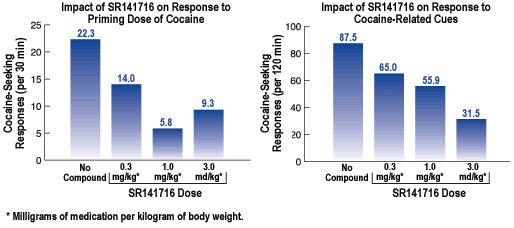Cocaine treatment patients who encounter people, situations, or settings they associate with past drug abuse often experience strong urges to use cocaine and slip back into addictive use. Such cue-induced relapse can occur long after patients have stopped using the drug. Now, research teams from Vrije Universiteit Medical Center in The Netherlands and NIDA's Intramural Research Program (IRP) in Baltimore have shown that they can dramatically reduce cue-induced relapse to cocaine-seeking in rats by blocking a specific type of brain receptor that is activated by cannabinoids, a class of chemicals that includes the active ingredient in marijuana. The study opens a promising new approach to developing medications that may help to prevent cue-induced relapse to cocaine abuse by humans.
 Compound Blocks Major Triggers of Drug Relapse. SR141716, a compound that blocks rats' CB-1 receptors, dramatically reduced resumption of cocaine-seeking responses triggered by two of the three most common triggers of relapse in humans: a priming dose of cocaine and environmental cues associated with cocaine reward. The compound did not reduce cocaine-seeking triggered by stress.
Compound Blocks Major Triggers of Drug Relapse. SR141716, a compound that blocks rats' CB-1 receptors, dramatically reduced resumption of cocaine-seeking responses triggered by two of the three most common triggers of relapse in humans: a priming dose of cocaine and environmental cues associated with cocaine reward. The compound did not reduce cocaine-seeking triggered by stress."We found that blocking cannabinoid (CB-1) receptors in the brain reduces the relapse-provoking effects of stimuli associated with past cocaine use without interfering with the brain's primary reward pathways," says Dr. Taco De Vries, who led the experiments in Amsterdam. This finding suggests that medications similar to the compound (SR141716) the researchers used to block this receptor may be able to help cocaine treatment patients remain abstinent without diminishing their capacity to experience pleasure from normally rewarding activities, he notes.
In the experiment, Dr. De Vries and Dr. Yavin Shaham of NIDA's IRP first trained rats to self-administer cocaine by poking their noses into a specific hole in their chambers. During daily training sessions, a light was turned on to indicate when cocaine was available and an electrical switch was clicked while cocaine was being administered. Once rats responded regularly for cocaine, researchers turned off the cocaine supply for 2 weeks. As a result, when the rats poked their noses into the hole during their daily drug-taking sessions, they got no cocaine and their drug-seeking behavior was gradually extinguished. The light and the clicking (light/click) cues that previously had accompanied cocaine administration were not turned on during these extinction sessions.
The researchers then established that the rats would resume nose-poking at the hole where they previously received cocaine when they were exposed to any of three major stimuli known to provoke relapse to cocaine abuse by humans after periods of abstinence:
- the drug itself -- a computer-controlled injection of a priming dose of cocaine;
- drug-related environmental cues -- the light/click stimuli previously linked to cocaine reward; and
- stress -- precipitated by intermittent electrical foot shocks.
Administering the compound that blocked the rats' CB-1 receptors before exposure to these stimuli significantly reduced cocaine-seeking triggered either by the priming dose of cocaine or by re-exposure to the light/click cues. The CB-1 antagonist did not affect resumption of cocaine-seeking triggered by the foot shock stressor. These results show that pharmacologically blocking the CB-1 receptor can selectively reduce the drug-stimulus effects of two of the three most common triggers of relapse to drug use.
Significantly, the researchers found that the CB-1 antagonist did not reduce cocaine self-administration in another group of rats that had not had the drug withdrawn to extinguish their cocaine-seeking behavior. This result shows the compound did not alter the rats' ability to experience cocaine's primary rewarding effects, Dr. De Vries says. The CB-1 antagonist also did not deter rats from continuing to self-administer sucrose, another rewarding substance. Together, these experiments indicate that primary brain reward pathways are not blocked by the cannabinoid antagonist and suggest that a CB-1 antagonist may be able to selectively block relapse provoked by cocaine cues or the drug itself without producing undesirable effects such as a general loss of ability to feel pleasure.
The CB-1 antagonist's failure to block relapse triggered by the foot shock stressor suggests that the neurobiological mechanisms of stress-induced reinstatement of cocaine-seeking are different from those of drug- and cue-induced reinstatement, says Dr. Shaham, who led this portion of the study. Studies by Dr. Shaham, Dr. Jane Stewart of Concordia University in Montreal, and Dr. Lin Lu of Shanghai Medical University indicate that stress-induced relapse is precipitated through activation of specific neurotransmitters in the brain that regulate the 's response to stressful situations. Compounds that block the release of these brain neurotransmitters or their action on their receptors have been shown to block stress-induced but not cue- or drug-induced reinstatement of cocaine-seeking.
With this new study, researchers have now identified underlying biological mechanisms involved in three of the most common precipitators of relapse to drug use, as well as compounds that effectively deactivate those mechanisms. "The next step would be to evaluate whether a CB-1 antagonist can be used in combination with agents that block the release of stress neurotransmitters as relapse-prevention medications," Dr. De Vries says.
Sources
- De Vries, T.J.; Shaham, Y.; et al. A cannabinoid mechanism in relapse to cocaine-seeking. Nature Medicine 7(10):1151-1154, 2001. [Abstract]
- Shalev, U.; Grimm, J.W.; and Shaham, Y. Neurobiology of relapse to heroin and cocaine-seeking: A review. Pharmacological Reviews 54:1-42, 2002.
